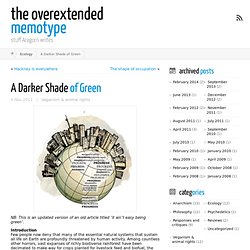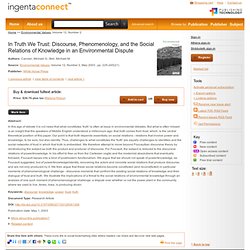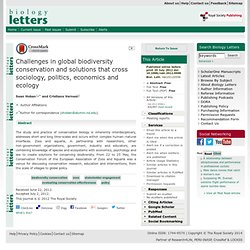

Financial Costs of Meeting Global Biodiversity Conservation Targets: Current Spending and Unmet Needs. The overextended memotype. NB: This is an updated version of an old article titled ‘it ain’t easy being green’.

Introduction Few people now deny that many of the essential natural systems that sustain all life on Earth are profoundly threatened by human activity. Among countless other horrors, vast expanses of richly biodiverse rainforest have been decimated to make way for crops planted for livestock feed and biofuel, the use of fossil fuels is at an all time high, the world’s oceans are fast being depleted of fish, water shortages are imminent in many parts of the world, the global food supply is threatened by GMOs and the atmosphere itself is thick with pollutants, affecting the climactic stability of our entire planet. We all care about these issues. Should we then feel guilty when we’re told that, collectively, these measures will not make a substantial impact, not even if every last one of us drove a Prius and had a solar geyser? Bright Green Environmentalism Going one step further, BG’s ask how we produce.
Synthese, Volume 185, Number 1. Our aim in the present paper is to approach the nature of life from the perspective of autonomy, showing that this perspective can be helpful for overcoming the traditional Cartesian gap between the physical and cognitive domains.

We first argue that, although the phenomenon of life manifests itself as highly complex and multidimensional, requiring various levels of description, individual organisms constitute the core of this multifarious phenomenology. Thereafter, our discussion focuses on the nature of the organization of individual living entities, proposing autonomy as the main concept to grasp it. In the second part of the article we show how autonomy is also fundamental to explaining major evolutionary transitions, in an attempt to rethink evolution from the point of view of the organizational structure of the entities/organisms involved. Abstract. Emotions can be considered inextricably linked to embodied appraisals - perceptions of bodily states that inform agents of how they are faring in the world relative to their own well-being.

Emotion-appraisals are thus relational phenomena the relevance of which can be learned or evolutionarily selected for given a reliable coupling between agent-internal and environmental states. An emotion-appraisal attentional disposition permits agents to produce behaviour that exploits such couplings allowing for adaptive agent performance across agent-environment interactions. This chapter discusses emotions in terms of dynamical processes whereby attentional dispositions are considered central to an understanding of behaviour. The need to reconcile a dynamical systems perspective with an approach that views emotions as attentional dispositions representative of embodied relational phenomena (embodied appraisals) is argued for.
Biosystems - Sustainable systems as organisms? 1.

What is life? 2. Sustainable systems as organisms? 3. How organisms make a living 4. 5. Biological Conservation - Thoughts towards a philosophy of nature conservation. In Truth We Trust: Discourse, Phenomenology, and the Social Relat. Buy & download fulltext article: Abstract: In this age of debate it is not news that what constitutes 'truth' is often at issue in environmental debates.

But what is often missed is an insight that the speakers of Middle English understood a millennium ago: that truth comes from trust, which, is the central theoretical position of this paper. Our point is that truth depends essentially on social relations - relations that involve power and knowledge, to be sure, but also identity. Thus, challenges to what constitutes the 'truth' are equally challenges to identities and the social networks of trust in which that truth is embedded. More about this publication? An Ecological Politics of Everyday Life: Placing Flesh on Whitehe. UNDERSTANDING AND PREDICTING ECOLOGICAL DYNAMICS: ARE MAJOR SURPRISES INEVITABLE.
Landscape Ecology, Online First™ Growing a resilient landscape depends heavily on finding an appropriate match between the scales of demands on ecosystems by human societies and the scales at which ecosystems are capable of meeting these demands.

While the dynamics of environmental change and ecosystem service provision form the basis of many landscape ecology studies, enhancing landscape resilience is, in many ways, a problem of establishing relevant institutions that act at appropriate scales to modify and moderate demand for ecosystem services and the resulting exploitation of ecosystems. It is also of central importance for landscape sustainability that institutions are flexible enough to adapt to changes in the external environment. The model provided by natural ecosystems suggests that it is only by encouraging and testing a diversity of approaches that we will be able to build landscapes that are resilient to future change. Environmental governance and its implications for conservation practice - Armitage - 2012 - Conservation Letters. Approaching a state shift in Earth/'s biosphere : Nature. Affiliations.

Trends in Ecology & Evolution - Restoration of ecosystem services and biodiversity: conflicts and opportunities. Reviews in American History, Vol. 34, No. 3 (Sep., 2006), pp. 399-406. What is the Scope of “History” in Historical Ecology? Issues of Scale in Management and Conservation - Historical Environmental Variation in Conservation and Natural Resource Management - Wiens. Challenges in global biodiversity conservation and solutions that cross sociology, politics, economics and ecology. Skip to main page content Biology Lettersrsbl.royalsocietypublishing.org Published online before print 25 July 2012 doi: 10.1098/rsbl.2012.0596 rsbl20120596 + Author Affiliations ↵*Author for correspondence (shoban@alumni.nd.edu).

Biodiversity, governance, and the allocation of international aid for conservation - Miller - Conservation Letters. Biological Conservation - Making conservation research more relevant for conservation practitioners. Abstract Conservation scientists and practitioners share many of the same goals. Yet in a majority of cases, we argue, research conducted by academic conservation scientists actually makes surprisingly few direct contributions to environmental conservation. We illustrate how researchers can increase the utility and impact of their scientific findings for real-world conservation, using examples of pressing environmental challenges. These examples demonstrate some practices and principles that scientists can adopt to better assist conservation practitioners and advance specific conservation outcomes. Biological Conservation - Trends in conservation biology: Progress or procrastination in a new millennium?
Private landowner interest in market-based incentive programs for endangered species habitat conservation - Rodriguez - 2012 - Wildlife Society Bulletin. Species Conservation, Rapid Environmental Change, and Ecological Ethics. Abstract. Khan Academy. What is Missing? Welcome to the Anthropocene. Animal Demography Unit. Ecological Modelling - System-of-Systems hierarchy of biodiversity conservation problems.
Abstract Many natural and man-made systems influence the well-being and sustainability of a country.

The state of biodiversity, water, air, and land are examples of the former whereas health, education, economy, and policies are examples of the latter. These systems are extremely involved and hard to model. To overcome some of the difficulties a System-of-Systems (SoS) approach is adopted. This paper models biodiversity as a SoS at various levels of organization, and each level is in turn modeled according to existing knowledge pertaining to that level. Highlights. Generations on the Land: A Conservation Legacy. International land deals: who is investing and where. Over the past few years, so-called "land grabs" have become an increasingly hot topic.

But reliable data has been hard to find. Now, an international coalition of NGOs and research groups has published the world's largest database of deals struck since 2000, offering unprecedented detail on who's investing, where and what for. The database, launched on Thursday, includes 1,006 deals covering 70.2m hectares (173m acres) – or roughly half the size of western Europe. Data on further deals will be added on an ongoing basis. Some highlights from the database: • Eastern Africa has the largest number of recent investments, with 310 deals.• Indonesia is the country with the largest area of land acquired by investors – 9.5m hectares. The Land Matrix database is now the most comprehensive public source for information on international land deals – but it is not perfect. This makes it difficult to draw too many conclusions from the data.
Data summary Download the data. TEDxEast - Bjarke Ingels - Hedonistic Sustainability. Land Use Policy - Security and equity of conservation covenants: Contradictions of private protected area policies in Australia. Abstract Private land conservation is becoming a popular policy approach, given the constraints of increasing public protected areas, which include reduced availability of land for purchase, insufficient budgets for acquisition, and escalating management costs of small, isolated reserves. Conservation covenants represent a common policy instrument, now prominent in the United States, Canada and Australia, employed to compliment the protected area network.
When ‘topsoil’ and subsoil, or ‘mineral’ use rights are decoupled, however, the security of covenants can become threatened if the country's economic policies take priority over conservation policies and mining is permitted where covenants exist. We discuss this issue on a theoretical level, examining four potential scenarios in which use rights are decoupled or coupled. Environmental governance and its implications for conservation practice - Armitage - Conservation Letters. What the ‘food security’ agenda means for animal conservation in terrestrial ecosystems - Gordon - 2012 - Animal Conservation.
Journal of Environmental Economics and Management - Endangered species conservation on private land: Assessing the effectiveness of habitat conservation plans. Abstract Habitat conservation plans (HCPs) have become a key instrument for implementation of the Endangered Species Act (ESA) on private land. However, there is no systematic analysis of their effectiveness in promoting endangered species recovery. This paper is the first to provide a comprehensive analysis of the impact of HCPs on species recovery status. We find evidence that HCPs have a significant positive impact on species recovery. Our results also suggest that the recovery benefits are larger when species have relatively larger plans.
Keywords. The Occupy movement and class politics in the US. Issue: 133 Posted: 9 January 12 Megan Trudell The Occupy movement that began in New York in September 2011 and has spread with remarkable speed across the country represents a massive shift in the politics of the United States.1 A year ago the seemingly inexorable rise of the Tea Party saw the startling resurgence of the right only two years after Obama’s election and the apparently decisive defeat of the Republicans. In a forthcoming book that has already been partly superseded by events, Thomas Frank launches a stinging attack on the “new right” in the US and makes the point that conservative gains were made thanks to the ideological void left by the Democratic government’s response to the crisis: “The bailouts combined with the recession created a perfect situation for populism in the Jacksonian tradition, for old-fashioned calamity howlers, for Jeremiahs raging against the corrupt and the powerful”.2 h2 Inequality in the US The table below starkly illustrates this.
Journal of Consumer Research, Vol. 13, No. 1 (Jun., 1986), pp. 71-84. Economic Valuation of Biodiversity Conservation: the Meaning of Numbers - MARTÍN-LÓPEZ - 2008 - Conservation Biology. Data Analysis To examine financial support for biodiversity conservation, we considered variables that economic-valuation theory suggests are important and variables that explain human attitudes toward biodiversity (Table 1). Contingent-valuation surveys are context-dependent, that is, the values estimated are subject to various aspects of the questionnaire design.
Although some elements of the survey are expected to be neutral (e.g., questions about family size should not influence an individual's response to the WTP question), others have a significant influence on a respondents' valuation (Bateman et al. 2002), such as the measure of benefits, vehicle of payment, how information was gathered (elicitation method), and timing of payment (Table 1). We classified the types of benefit measures as WTP to avoid a loss, WTP to secure a gain, and WTP to invest in a biodiversity plan. We classified payment vehicles as voluntary or coercive. Agriculture, Ecosystems & Environment - The status of agrobiodiversity management and conservation in major agroecosystems of Southern Africa. Volume 157, 15 August 2012, Pages 17–23. Biodiversity and Conservation, Online First™ Biological Conservation - Improving estimates of biodiversity loss. Biological Conservation - Global food security, biodiversity conservation and the future of agricultural intensification.
Managing fire mosaics for small mammal conservation: a landscape perspective - Kelly - 2012 - Journal of Applied Ecology. Origins, Uses, and Transformation of Extinction Rhetoric. Buy & download fulltext article: Environmental and Resource Economics, Online First™ The Convention on Biological Diversity’s (2010) target to reduce the rate of biodiversity loss was achieved by very few countries.
Why? We use the theory of conservation implicit in the Hotelling model of non-renewable resource pricing to analyze the problem, distinguishing between the benefits to countries where conservation takes place, and to other countries. Science communication for biodiversity conservation 10.1016/j.biocon.2011.12.016 : Biological Conservation. Conservation implications of recent advances in biodiversity–functioning research 10.1016/j.biocon.2011.12.005 : Biological Conservation.
Conservation implications of the refugee species concept and the European bison: king of the forest or refugee in a marginal habitat? - Kerley - 2011 - Ecography. Large-scale distribution patterns of carnivores in northern South Africa: implications for conservation and monitoring. Assessing market-based conservation governance approaches: a socio-economic profile of Indonesian markets for wild birds.
The Quarterly Review of Biology, Vol. 86, No. 3 (September 2011), pp. 220-221. Conservation in the Anthropocene - CARO - 2011 - Conservation Biology. Land Trust Evaluation of Progress toward Conservation Goals - ALEXANDER - 2011 - Conservation Biology. Global Environmental Politics. November 2011, Vol. 11, No. 4, Pages 1-21 Posted Online October 18, 2011. (doi:10.1162/GLEP_a_00081) © 2011 by the Massachusetts Institute of Technology.
European Journal of Wildlife Research, Online First™ Ecosystem services, targets, and indicators for the conservation and sustainable use of biodiversity. Trends in Ecology & Evolution : Biodiversity and ecosystem services: a multilayered relationship. Analysis & writing tools. Three-dimensional woody vegetation structure across different land-use types and land-use intensities in a semi-arid savanna (2009), 2009-07 [Fisher, J, Erasmus, BFN, Witkowski, E, Van Aardt, J, Asner, G, Kennedy-Bowdoin, TY] Valuing the Arc Home. Southern African Bird Atlas Project 2.